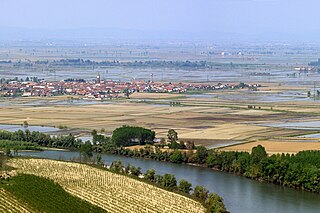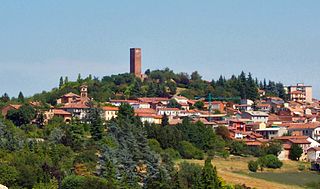
Montferrat is a historical region of Piedmont, in northern Italy. It comprises roughly the modern provinces of Alessandria and Asti. Montferrat is one of the most important wine districts of Italy. It also has a strong literary tradition, including the 18th century Asti-born poet and dramatist Vittorio Alfieri and the Alessandrian Umberto Eco.

The province of Alessandria is an Italian province, with a population of some 425,000, which forms the southeastern part of the region of Piedmont. The provincial capital is the city of Alessandria.
Rainier or Renier, son of William IV, Marquis of Montferrat, was the sixth ruler of the state of Montferrat in north-west Italy from about 1100 to his death, and the first such to be identified in contemporary documents as Margrave of Montferrat.

Casale Monferrato is a town in the Piedmont region of northwestern Italy, in the province of Alessandria. It is situated about 60 km (37 mi) east of Turin on the right bank of the Po, where the river runs at the foot of the Montferrat hills. Beyond the river lies the vast plain of the Po valley.

Gabiano is a rural comune in the northwest of the province of Alessandria, some 25 kilometres (16 mi) west of Casale Monferrato. This area straddles the lowland immediately south of the Po and the furthest extension of the Monferrato hills. Its current population of some 1,250 has halved since mid-1930s.

Moncalvo is a village and comune in the Province of Asti in the Italian region Piedmont, located about 45 kilometres (28 mi) east of Turin and about 15 kilometres (9 mi) northeast of Asti on the national road SS 547 which links Asti to Casale Monferrato and Vercelli. Historically it was part of the state of Montferrat and was of particular importance during the early years of the Paleologi period of the marquisate. Its best-known inhabitants were the Baroque painter Guglielmo Caccia and ‘La Bella Rosin’, King Victor Emmanuel II’s favourite mistress and eventually wife.
Montemagno is a comune (municipality) in the Province of Asti in the Italian region Piedmont, located about 50 kilometres (31 mi) east of Turin and about 13 kilometres (8 mi) northeast of Asti. As of 31 December 2010 it had a population of 1,228 and an area of 15.9 square kilometres (6.1 sq mi).

Nizza Monferrato is a comune (municipality) in the Province of Asti in the Italian region of Piedmont, located about 60 kilometres (37 mi) southeast of Turin and about 20 kilometres (12 mi) southeast of Asti.

San Marzano Oliveto is a comune (municipality) in the Province of Asti in the Italian region Piedmont, located about 60 kilometres (37 mi) southeast of Turin and about 20 kilometres (12 mi) southeast of Asti.
Montiglio Monferrato is a comune in the Province of Asti in the Italian region Piedmont, located in the Valle Versa about 30 kilometres (19 mi) east of Turin and about 20 kilometres (12 mi) northwest of Asti. It was created in 1998 by combining the three communes of Colcavagno, Montiglio and Scandeluzza. The fourth principal population centre is the village of Rinco; this also was a commune in its own right until 1916 when it was absorbed by Scandeluzza.

Camagna Monferrato is a comune (municipality) in the Province of Alessandria in the Italian region Piedmont, located about 60 kilometres (37 mi) east of Turin and about 20 kilometres (12 mi) northwest of Alessandria.

Montechiaro d'Acqui is a comune (municipality) in the Province of Alessandria in the Italian region Piedmont, located about 70 kilometres (43 mi) southeast of Turin and about 40 kilometres (25 mi) southwest of Alessandria.

Occimiano is a comune (municipality) in the Province of Alessandria in the Italian region Piedmont, located about 60 kilometres (37 mi) east of Turin and about 20 kilometres (12 mi) northwest of Alessandria.
Odalengo Piccolo is a commune (comune) of the Province of Alessandria in the northwest Italian region Piedmont. It is located in the Val Cerrina about 40 kilometres (25 mi) east of Turin, about 13 kilometres (8 mi) north of Asti and some 20 kilometres (12 mi) southwest of Casale Monferrato. The municipality extends over an area of 7.63 square kilometres (2.95 sq mi) in the hills to the south of the Stura del Monferrato torrent, where areas of woodland are interspersed by vineyards. It borders on the communes of Alfiano Natta, Castelletto Merli, Cerrina Monferrato, Odalengo Grande, and Villadeati.
San Giorgio Monferrato is a comune of the Province of Alessandria in the Italian region Piedmont. It is about 60 kilometres (37 mi) east of the regional capital Turin and about 25 kilometres (16 mi) northwest of Alessandria.

San Salvatore Monferrato is a comune (municipality) in the Province of Alessandria in the Italian region Piedmont, located about 70 kilometres (43 mi) east of Turin and about 10 kilometres (6 mi) northwest of Alessandria.

Villanova Monferrato is a comune (municipality) in the Province of Alessandria in the Italian region Piedmont, located about 60 kilometres (37 mi) east of Turin and about 30 kilometres (19 mi) northwest of Alessandria and about 17 kilometres (11 mi) south of Vercelli. Located in the plain to the left of the Po, it the most northerly comune in the province, and borders on the comuni of Caresana, Motta de' Conti, Rive, and Stroppiana in the Vercelli, as well as those of Balzola and Casale Monferrato in the Province of Alessandria.

Visone is a comune (municipality) in the Province of Alessandria in the Italian region Piedmont, located about 80 kilometres (50 mi) southeast of Turin and about 30 kilometres (19 mi) southwest of Alessandria. Its name becomes from the homonymous Visone creek, that flows into its territory and enters Bormida river not far from the village.

The Rotaldo, known in its upper course as the Laio, is a 40-kilometre (25 mi) river of northern Italy, and a right-side tributary of the Po River. Most of its course falls within the Province of Alessandria and all of it within the former Province of Casale. The river is of modest flow and is heavily reliant on rainfall with a discharge near its mouth of 1.6 cubic metres per second (57 cu ft/s).
Sebastiano Guala was an Italian church architect active between 1640 and 1680 in the area of Casale Monferrato, then capital of the Gonzaga-ruled state of Montferrat. He was born into a prominent family of Frassinello Monferrato and became a canon of the Collegiata di Santa Maria di Piazza in Casale. It has been thought probable that he belonged to the same family as the Casalese painter Pier Francesco Guala (1698–1757).




















